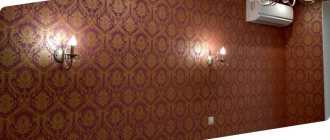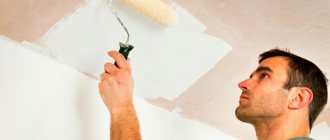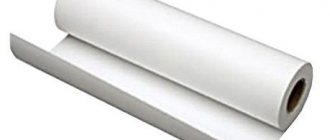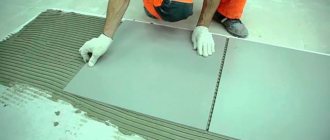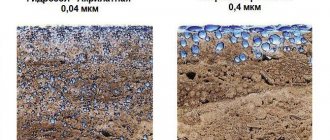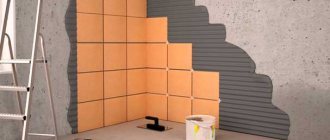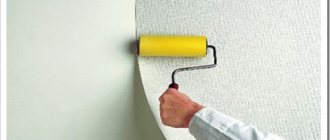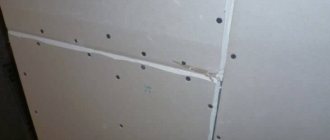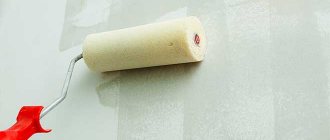Priming drywall before puttying: is it necessary?
Initially, you need to determine for what purpose the surface priming procedure is generally necessary. First of all, this is done in order to protect the coating from mold and fungi, especially in rooms with high humidity levels.
Bathroom lining with plaster for further priming Source sense-life.com
Also, applying a layer of primer is also necessary in order to make adhesion to finishing materials stronger. As for the question of whether it is necessary to prime drywall before puttying, this is one of the mandatory measures at the rough finishing stages.
Wall priming should be done in cases where:
- you will need to glue the surface with wallpaper;
- paint after puttying;
- need to lay tiles;
- A layer of plaster will be applied.
But applying a layer of primer is not necessary for all types of drywall. That is, if the surface is moisture resistant, then the use of this composition before filling is not required. Experts also do not recommend using primer if you need to apply finishing putty to the plaster.
On a note! The application of primer compounds is necessary to make the surface stronger, which will preserve and extend the service life of the material.
Manipulation of priming of plasterboard construction Source gruntovka-kraska.ru
Why do you need a primer?
Beginning craftsmen and those who are renovating their apartment for the first time in their lives sooner or later wonder why it is necessary to apply a primer, because it does not level the walls and does not give any visible effects.
In fact, everything is exactly the opposite. After all, it is the presence of a primer or its absence that directly affects the quality of adhesion of the putty to the wall. If the surface is not primed, the putty will crack or fall off altogether.
In addition, the primer protects the wall from fungus, mold, moisture and insects that may live in the room. Experienced craftsmen recommend applying a primer in at least two layers, this will smooth out all surface imperfections.
Tip: Since primer comes in different colors, it is best to choose the one that best matches the topcoat. But it is best to choose transparent.
Arguments for and against priming plasterboard walls
When carrying out repair work, you should understand when it is necessary to carry out priming, and when it is better to abandon this idea. To do this, let's look at several arguments for and against applying a fixing layer.
Why you need to prime drywall:
- This material has a consistency that allows the compounds to penetrate into the pores of the drywall and fill them. This will save the use of all other building materials that will subsequently be applied to this surface.
- Polymerization occurs, which subsequently creates a strong frame on the surface of the gypsum board. Thanks to this, the material is able to withstand vertical loads of almost any intensity.
- Putty without applying a primer on drywall is not capable of creating the same high-quality coating. The result is uneven layers, and subsequently the coloring composition will lie unevenly.
- The walls will not limit vapor permeability; therefore, moisture will not accumulate inside the layers, which means the formation of mold and the development of fungal infections is completely excluded.
Only when deciding to prime plasterboard walls, you need to take into account that ideally acrylic-based compositions are suitable, because they are harmless to human health.
Applying primer to gypsum using a roller to obtain an even layer Source kraski-net.ru
Do I need to treat the surface before puttying?
The person who started the repair hopes that the finishing treatment will last quite a long time. This requires appropriate preparation before puttying. Priming before plastering walls has the following functional significance:
- Wooden, brick, concrete, as well as plasterboard products - have microcracks and visible damage, the primer fills them, thereby performing a strengthening function on any surface;
- This material significantly improves the adhesion of putty and its even distribution on the object;
- This treatment also saves expensive building materials. Filled wall pores do not absorb paint or glue;
- The solution creates a solid surface, this property is designed to prevent the formation of any stains on the treated surface;
- Performs an antiseptic mission. Prevents mold or mildew from appearing.
The question of whether it is necessary to prime the walls before puttying disappears. The answer is definitely!
This material significantly improves the adhesion of putty and its even distribution on the object.
Types of primers that can be used for drywall
To choose what to prime the drywall before puttying, you need to take into account what type of material will be used to complete the final finish. Let's consider which ones are most effective in each specific case.
- Acrylic. These compounds are considered the most popular, as they are versatile and can be applied both before and after puttying work. Drying time does not exceed 2-4 hours.
- Phenolic. Apply only in one layer and only under a layer of putty. There are several such compositions, so before you purchase it, you need to study the information on the packaging to see if the composition is suitable for use in a residential area.
- Alkyd. They are mainly intended for wood, but there are cases when they can also be used for drywall, but only applied strictly under the putty layer.
- Polyvinyl acetate. They are easily applied to gypsum board, creating a strong coating, but the caveat is that in the future you can only use paints with the same base.
- Glypthal. The data is characterized by a very high adhesion rate, which will accordingly create a more reliable connection. Such compositions are used even outside buildings, as well as indoors with effective ventilation.
- Perchlorovinyl. They will try to use such products to a greater extent for brick and already puttied plasterboard surfaces.
Liquid primer for treating plasterboard surfaces Source gdematerial.ru
When choosing a primer for plasterboard before puttying, you should additionally focus on certain types of finishing material that will be used for finishing work. For example, heavy wallpaper requires a primer with deep penetration ability. For painting work, a simple primer composition is sufficient.
Wall treatment
Take a brush, roller or a special spray bottle. We apply the primer evenly - putty involves the use of thin layers, so the surface should remain free of blemishes and empty spaces. The surface should remain free of blemishes and empty spaces. The choice of transparent compounds leads to difficulties during processing. This concerns everyone who is interested in the question of whether it is necessary to prime the putty before painting.
The process is easy to track by how long and how the walls are wetted. How long after priming can I putty? ?
Look for information on the packaging. The main thing is to understand in advance how many layers to prime the walls before puttying. After the first layer is applied, does the wall begin to dust and crumble? This means that the procedure must be repeated. The action is repeated several times until the surface stops absorbing the material.
A common mistake made by beginners is to first apply one coat of primer. This is wrong, because this way the mixture will not stick well.
Place the second layer on top when the previous one has dried. The instructions on the packaging will help you understand how long the wait takes and figure out what to prime the walls with before puttingty .
Treating walls with primer and putty is an important and responsible process. But to implement it, it is not necessary to invite craftsmen who can plaster the surface. Following the instructions allows you to handle the treatment of walls before puttying on your own.
Recommendations from priming experts (2 videos)
Brands and primer work (23 photos)
Selecting a primer based on internal composition
You need to buy material to create adhesion between drywall and finishing material from a trusted manufacturer. And then be guided by the following criteria:
- appointment. That is, what type of finishing will the composition be used for and in what specific room will this type of repair work be carried out;
- analysis of the constituent components in the selected soil, among which you need to be able to distinguish harmful impurities from safe ones;
- type of penetration. It can be deep or shallow. Each of them is used in individual cases;
- degree of reliability and service life. These indicators determine how long the cladding will last from the moment it is applied to the prepared plaster.
In the best case, you need to take an expensive version of the composition and compare it with the budget version in terms of composition and main characteristics. As a result, you yourself will be able to determine which type is most suitable.
Primer for drywall Source gdematerial.ru
Selecting soil for different types of walls
Walls can be made of various materials. In addition to the popular wall materials of concrete blocks or bricks, wood or metal products are much less commonly used for walls. Recently, plasterboard sheets have been used for interior cladding - a modern building material with a flat and smooth surface made of thick kraft cardboard, which is difficult to treat with putty without prior priming.
When choosing the type of primer, it is necessary to take into account the technical features of the variety of wall surfaces and select a composition in which priming will give the maximum effect:
- Before filling, walls made of brick and plasterboard are treated with universal acrylic primers. The liquid penetrates the pores of the wall material and, after being absorbed by the surface, prepares the walls as much as possible for applying the finishing layer. Among the large list of popular types of acrylic primers for universal use, the leading place belongs to the ST-17 primer of the famous brand Cerrazit.
- Concrete, gas silicates, and cinder blocks have a smooth outer surface with a small number of open pores. Puttying such surfaces has always caused difficulties, and without first applying special products, further processing simply does not make sense. Smooth wall surfaces are treated with adhesive primers, which impart the necessary roughness. The primer greatly improves the adhesion of the base and putty. An example is adhesive soils such as Betonokontakt or St-16 - polymer mixtures with quartz or synthetic fillers.
- Sheet metal surfaces require a completely different approach to the selection of primers. The most important problem of metal products is their susceptibility to the unpleasant destructive phenomenon of corrosion, which negatively affects the appearance of the structure and the strength properties of the material. For this reason, the main criterion when selecting a primer composition for metal will be to provide an anti-corrosion protective coating that protects against rust. An example is the popular primer GF-021.
- Walls coated with wood have an increased vulnerability to dampness, mold and damage from various harmful insects. When choosing a product for treating wooden surfaces, you should give preference to water-based primers with antibacterial additives, which effectively protect the wood from all negative factors. Before the advent of special types of primers, the wood was first coated with natural drying oil, which created a reliable protective coating.
When choosing a primer for each specific type of wall covering, preference should be given to building finishing materials of the same brand. The compatible technical properties and indicators of such materials ensure maximum and long-term results of the final decorative coating.
When priming walls, it is important to choose only high-quality products, otherwise peeling of the putty solution and the finishing coating may occur.
What is the best primer for wood putty?
Treating a wooden surface with a primer before applying finishing compounds provides reliable protection against many negative phenomena, such as the penetration of moisture into the wood fibers, the development of mold, the appearance of fungus, the occurrence of rotting and damage by various insects - wood borers. Along with its protective functions, priming provides good adhesion to putty and paint compositions necessary to level out uneven wooden surfaces, impart smoothness and increase the service life of the entire wooden wall covering.
Wood primers differ in their composition into the following types:
- Mineral, created on the basis of cement binders.
- Alkyd, with a base of alkyd resins, and intended for the treatment of new and previously painted wood surfaces.
- Acrylic compositions with excellent adhesion and durable film coating.
- Silicone is an acrylic mixture designed to protect wood from atmospheric moisture. Wooden structures treated with this primer are characterized by stable humidity and perform well in conditions of fluctuating humidity levels. To achieve a waterproof effect, the wooden surface must be primed in several layers.
- Polyurethane compounds created on the basis of durable synthetic polyurethane resins. The primer is recommended for processing parquet plank floors and coatings, which have increased requirements for strength and wear resistance.
All these types of wood primers share the same general method of application: roller, brush or spray.
You can find the primer on sale in a convenient aerosol package. The main convenience of aerosol spraying of primer is the ability to treat hard-to-reach places and deep cracks. In addition, thanks to volatile components, this primer dries quickly. Unfortunately, aerosol spraying does not provide a clear understanding of the number of layers applied and, in addition, the liquid is quickly consumed.
The priming process: A to Z
Let's look at how to prime drywall before puttingty. To do this, you need to prepare a roller and a brush with small bristles (useful for treating hard-to-reach places). In some cases, a spray bottle is also suitable, especially if you need to process large volumes. Another mandatory point is personal protection (disposable gloves and a respirator). The entire processing process will consist of several stages:
- First of all, the smoothness of the surface is improved, all edges are removed, and the heads of the screws are recessed, but not too deeply.
- Next, the surface is cleaned of dust and debris, and remnants of building materials. Ideally, this work should be done with a separate, clean, soft paint brush.
- The joints and seams are covered with a special reinforcing mesh. You may also need more sickle tape.
Priming a plasterboard surface with a roller Source gdematerial.ru
When the surface is prepared in this way, you can begin application. It represents the following technology:
- First you need to read the instructions on the package, and then dilute the composition in accordance with it.
- The first coat of primer should be applied first to seams, joints and places where screws are recessed.
- Then this layer is left until completely dry, only after which the next one is applied, which completely covers the entire surface.
- Again, the layer is left until completely dry, after which the dried area of plasterboard is sanded.
- Afterwards, the plasterboard sheets are puttied, but in this case it is advisable to choose models of starting and finishing putties from the same company as the gypsum board.
Priming the surface of plasterboard structures Source elka-palka.ru
Note! Application of the primer should only be carried out at an air temperature of at least 15 degrees, and humidity levels should also be within 75-80%. Is it necessary to prime plasterboard walls before puttying if the dampness level in the room is too high - definitely not. The surfaces need to be dried.
Preparation process
The sequence of actions will be as follows:
- Complete removal of dirt from walls. It is necessary to blow off the dust and get rid of adhering particles of the solution itself, and remove the old coating to the base.
- If there is a high level of humidity on the walls, it is necessary to dry them before using the primer. It’s easier to use a hair dryer, otherwise you won’t achieve the desired result. Then it doesn’t matter what is used: putty, primer .
- Degreasing compounds will help get rid of greasy stains.
The selected primer or putty must be prepared for further use in advance. If you have a ready-made composition, it is better to place it in a special container. Then it will be convenient to dip the instrument chosen by the buyer.
Soil drying time
You can find out the drying time on the packaging of the product. Usually this period is individual depending on the basis on which it is made:
- alkyd - 20 hours;
- acrylic - 5 hours;
- glypthal - 24 hours.
Experts in the field do not advise applying putty to a layer of adhesive material that has not yet dried.
Applying a primer to a plaster wall and waiting for the layer to dry Source kraski-net.ru
Do-it-yourself wall preparation
Putty without primer is like a soldier without a rifle. Any master will tell you this. Note that after these processes, a white wall is ready for work, through which the grayness of the concrete does not show through. If you plan to hang light wallpaper, then the shade of the wall matters.
Priming walls is a simple process
Preparing the walls for putty
- So, we have decided on the choice of product. Now let's do the calculations. The area of a room with four walls is easy to measure. We add the length and width of the walls, multiplying the resulting amount by two. This is how we find out the perimeter, which we multiply by the height of the room. The average consumption of the composition is 100-200 ml per 1 m2. If the material is loose and the primer is well absorbed, you will have to apply repeated layers, in which case more solution is needed.
- Make sure the surface is clean and dry, free of dust, debris and wet spots.
- If preference is given to a primer in the form of a concentrate, dilute it not 1:6, but 1:3, which will improve the quality of the work.
- Some craftsmen use a spray bottle to apply the solution; the disadvantage of this use is that it is difficult to clean the system after work. Most often they are primed using a roller and brush.
- The floor should be covered with paper or film. If white liquid gets on it, it will take a long and tedious time to wash it off.
- Primer for walls is applied from bottom to top. To prevent dripping and flowing, remove excess from the working tool.
- Proceed with re-processing after the previous layer has dried.
Learn more about priming walls in the video below:
Tip: Drywall also needs impregnation. This will make it easier to change wallpaper when renovating. Otherwise they will stick tightly to the surface. A white primer is suitable for this.
Simple application tips
Also, before application, we recommend that you familiarize yourself with the tips for applying a primer under the base of each specific facing material. Let's take a closer look.
Under the wallpaper
If in the end you need to stick wallpaper on plasterboard surfaces, then you first need to unstitch all the seams and work out the joints. Only after this you need to begin the priming procedure: initially, all recesses are treated with a brush. At the end of this process, wait until it dries, and then putty the problem areas first.
Under tiles
Priming the drywall under the tiles is mandatory; this will ensure a stronger connection. This composition will allow the material to adhere more firmly to a vertical surface in the future.
In the kitchen, bathroom and other rooms where there will be high humidity, it is advisable to carry out a two-layer treatment of plasterboard surfaces with a primer. Then the composition is simply left until completely dry, after which the surface is puttied and only then the final finishing is performed.
Do I need to prime the walls before puttingty after plastering?
The primer composition must be applied without fail. Both walls and ceilings need to be treated. This approach allows you to strengthen the surface and improve absorbency, as well as increase the adhesion of the layers together with the topcoat. Therefore, to the question - is it necessary to prime before puttying, the answer is affirmative.
Video description
Plastering drywall from A to Z. Video tutorial: where to start?
For painting
When applying a primer for drywall before painting, it is very important to be careful, since the surface should be very smooth, without visible differences. The first thing to be primed in this case is problem areas where moisture and bacteria can penetrate first.
It is best to carry out the work with a roller, having previously moistened it in a container with soil, and it is extremely important to remove excess composition to avoid drips. Ideally, you should get walls with a high-quality, flat surface. In this state, leave the vertical surface to dry and then begin painting.
How to apply primer to a wall
The composition is applied to a previously prepared surface:
- fragile parts of the base must be removed, for example, old crumbling plaster or peeling paint;
- construction contaminants are removed, degreasing is carried out - in the presence of oil and fat deposits, for example, drying oil;
- the surrounding area must be covered with a protective material - accidentally applied and then dried primer is difficult to remove.
Since most types of primer are liquids with varying viscosities, application is carried out using paint rollers or brushes. Concrete contact is a paste-like consistency, so it is more convenient to use a spatula or a brush with hard bristles.
